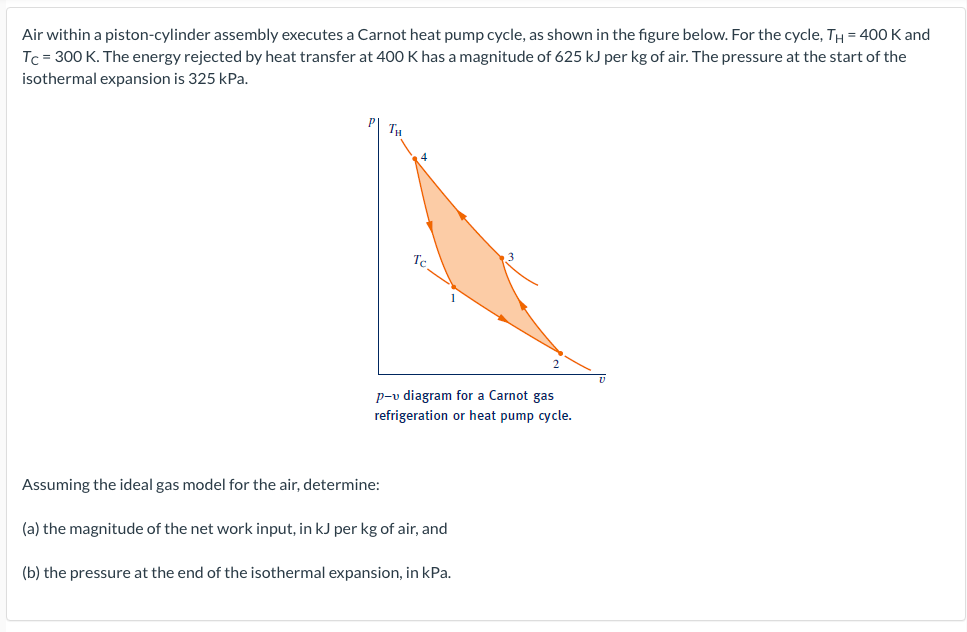Air within a piston-cylinder assembly executes a Carnot heat pump cycle, as shown in the figure below. For the cycle, TH = 400 K and Tc = 300 K. The energy rejected by heat transfer at 400 K has a magnitude of 625 kJ per kg of air. The pressure at the start of the isothermal expansion is 325 kPa. TH Tc. p-v diagram for a Carnot gas refrigeration or heat pump cycle. Assuming the ideal gas model for the air, determine: (a) the magnitude of the net work input, in kJ per kg of air, and (b) the pressure at the end of the isothermal expansion, in kPa.
Air within a piston-cylinder assembly executes a Carnot heat pump cycle, as shown in the figure below. For the cycle, TH = 400 K and Tc = 300 K. The energy rejected by heat transfer at 400 K has a magnitude of 625 kJ per kg of air. The pressure at the start of the isothermal expansion is 325 kPa. TH Tc. p-v diagram for a Carnot gas refrigeration or heat pump cycle. Assuming the ideal gas model for the air, determine: (a) the magnitude of the net work input, in kJ per kg of air, and (b) the pressure at the end of the isothermal expansion, in kPa.
Refrigeration and Air Conditioning Technology (MindTap Course List)
8th Edition
ISBN:9781305578296
Author:John Tomczyk, Eugene Silberstein, Bill Whitman, Bill Johnson
Publisher:John Tomczyk, Eugene Silberstein, Bill Whitman, Bill Johnson
Chapter45: Domestic Refrigerators And Freezers
Section: Chapter Questions
Problem 2RQ: The operating condition for the single compressor in a household refrigerator is the lowest box...
Related questions
Question

Transcribed Image Text:Air within a piston-cylinder assembly executes a Carnot heat pump cycle, as shown in the figure below. For the cycle, TH = 400 K and
Tc = 300 K. The energy rejected by heat transfer at 400 K has a magnitude of 625 kJ per kg of air. The pressure at the start of the
isothermal expansion is 325 kPa.
TH
Te
p-v diagram for a Carnot gas
refrigeration or heat pump cycle.
Assuming the ideal gas model for the air, determine:
(a) the magnitude of the net work input, in kJ per kg of air, and
(b) the pressure at the end of the isothermal expansion, in kPa.
Expert Solution
This question has been solved!
Explore an expertly crafted, step-by-step solution for a thorough understanding of key concepts.
This is a popular solution!
Trending now
This is a popular solution!
Step by step
Solved in 2 steps with 2 images

Knowledge Booster
Learn more about
Need a deep-dive on the concept behind this application? Look no further. Learn more about this topic, mechanical-engineering and related others by exploring similar questions and additional content below.Recommended textbooks for you

Refrigeration and Air Conditioning Technology (Mi…
Mechanical Engineering
ISBN:
9781305578296
Author:
John Tomczyk, Eugene Silberstein, Bill Whitman, Bill Johnson
Publisher:
Cengage Learning

Principles of Heat Transfer (Activate Learning wi…
Mechanical Engineering
ISBN:
9781305387102
Author:
Kreith, Frank; Manglik, Raj M.
Publisher:
Cengage Learning

Refrigeration and Air Conditioning Technology (Mi…
Mechanical Engineering
ISBN:
9781305578296
Author:
John Tomczyk, Eugene Silberstein, Bill Whitman, Bill Johnson
Publisher:
Cengage Learning

Principles of Heat Transfer (Activate Learning wi…
Mechanical Engineering
ISBN:
9781305387102
Author:
Kreith, Frank; Manglik, Raj M.
Publisher:
Cengage Learning